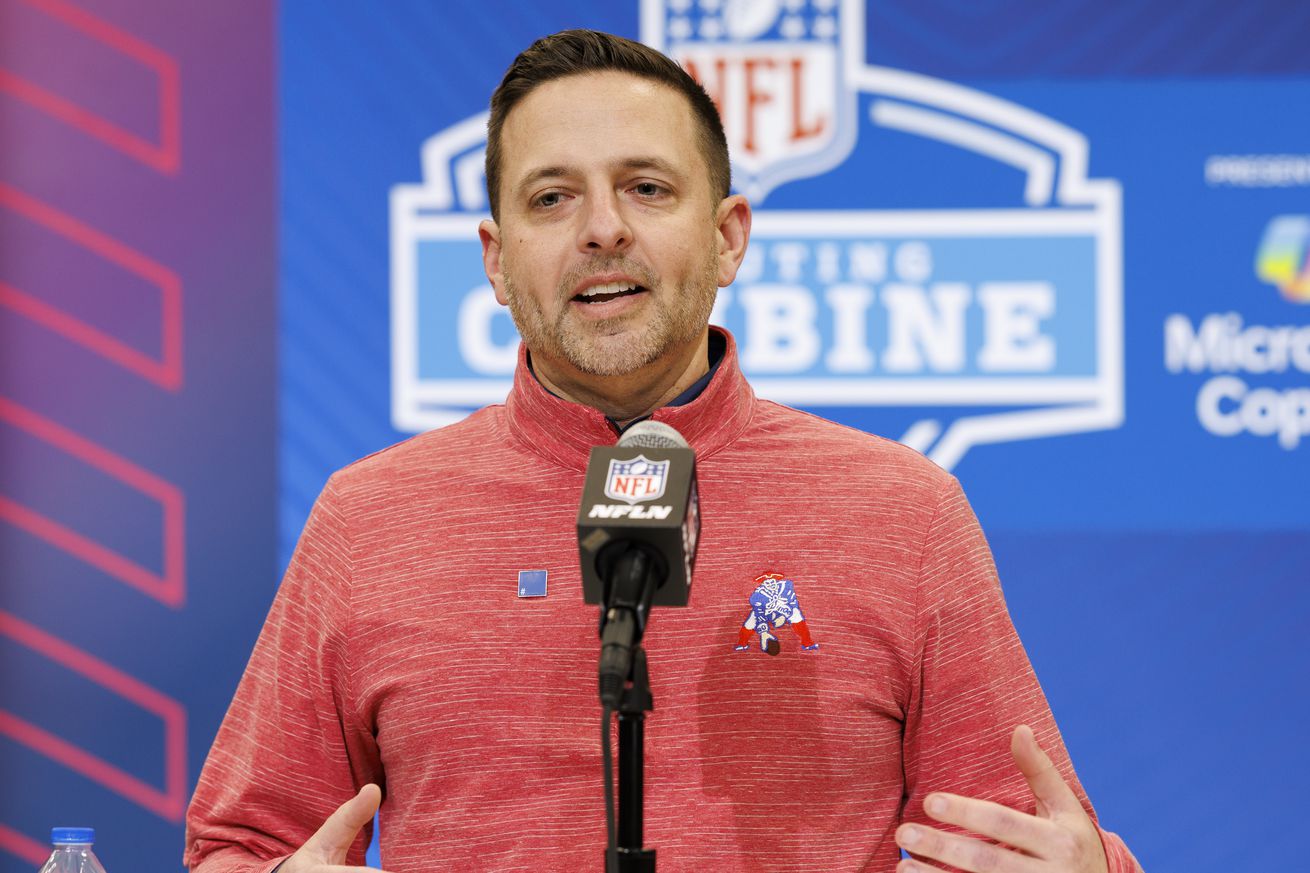
New England made five total trades during the 2025 NFL Draft
The New England Patriots were quite busy during the NFL Draft. Besides adding 11 new players to their roster, they also made a series of trades to acquire some of those and increase their future capital.
“I think that’s the fun part about the draft,” vice president of player personnel Ryan Cowden said on the final day of the draft. “Sometimes opportunities don’t present themselves. There’s always got to be two partners, right? There’s got to be somebody willing to come up and somebody willing to go down. What you try to do is just as best you can.”
In total, Cowden and the rest of the Patriots’ decision makers — Eliot Wolf, Mike Vrabel, Alonzo Highsmith, Matt Groh — found four different trade partners for five different trades. Using the different trade charts collected by NFL analyst Joseph Hefner, let’s take a look at them to see how the team performed from a value perspective.
Before starting out, though, a quick word on the different charts. There are two types: trade charts and player value charts. In the simplest of terms, the first group aims at analyzing the value teams put on the different selections, while the others look at how players selected in those spots have historically performed relatively to factors such as their rookie contract values.
Trade No. 1: Down with Carolina
The Patriots’ first trade of the draft came in the third round, when they decided to move back eight spots with the Carolina Panthers. Going from No. 77 to No. 85, they picked up an extra fifth-rounder — No. 146 — along the way.
From a value perspective, the trade looks like this:
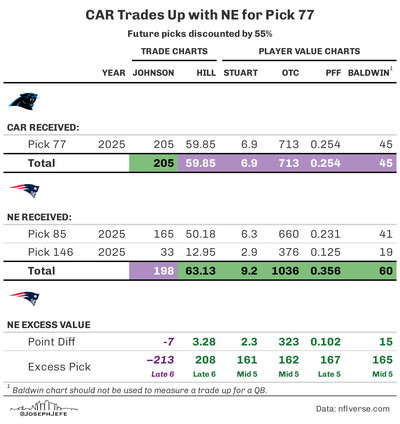
The Patriots got the superior value out of the trade if we use the surplus models; with the exception of the outdated Jimmy Johnson chart, they come out ahead in all of the other models. However, we can already see a theme that will remain relevant with the other four trades as well: the general value exchanged is pretty even.
Differences between the two teams can either be attributed to a club’s willingness to make a move rather than a selection, or to slightly different value charts being used by the teams involved. Or, both.
As for the actual picks involved in the trade, they were reinvested as follows:
- Carolina: 3-77 (ED Princely Umanmielen)
- New England: 3-85 (traded to Kansas City), 5-146 (ED Bradyn Swinson)
Trade No. 2: Down with Kansas City
After trading down eight slots from No. 77 to No. 85, the Patriots decided to move down the board a second time. This time, they picked up a future selection in the process: making a trade with the Kansas City Chiefs, they gave up No. 85 for No. 95 and a 2026 fourth-rounder.
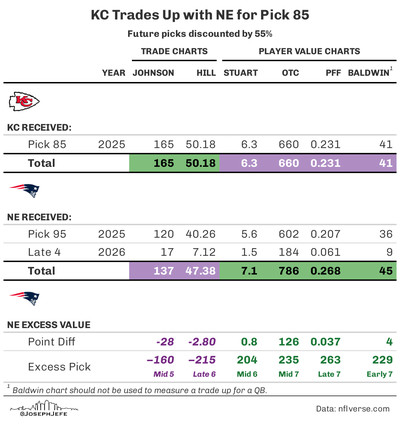
Analyzing the value of that trade involves some guesswork. For starters, there is no telling where Kansas City’s fourth-rounder will end up; for the purpose of this analysis, however, we assume the three-time reigning AFC champions will again be a playoff-caliber team in 2025. We also do not know how teams value future picks; historical analysis puts the discount at around 55 percent.
Putting all of that into consideration, the trade itself once again is quite fair; the differences are relatively marginal on the “modified” charts (i.e. not the Johnson chart that made its debut in the early 1990s).
The selections themselves, meanwhile, were spent like this:
- Kansas City: 3-85 (CB Nohl Williams)
- New England: 3-95 (C Jared Wilson), 2026 4th-rounder (TBD)
Trade No. 3: Up with Seattle
After moving down the board twice on Day 2 of the draft, the Patriots decided to go in the opposite direction early on Day 3: they used the 144th and 238th overall picks to move up to No. 137 in a trade with the Seattle Seahawks.
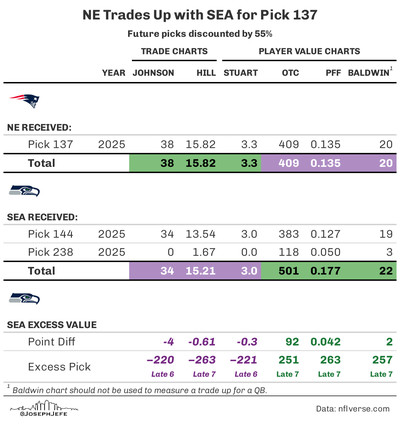
Value-wise, this trade follows the theme of the draft for the Patriots: it is pretty fair, regardless of the eventual excess pick value; the value of a late seventh-round pick going one way or another is a negligible difference in teams’ eyes.
As for the picks, they were used like this:
- New England: 4-137 (DT Joshua Farmer)
- Seattle: 5-144 (traded to Cleveland), 7-238 (WR Ricky White III)
Trade No. 4: Down with Detroit
Following their trade up into the backend of the fourth round, the Patriots moved down the board again in Round 5 when they shipped No. 171 — a pick originally obtained in the Joe Milton trade — to the Detroit Lions for No. 182 and No. 228.
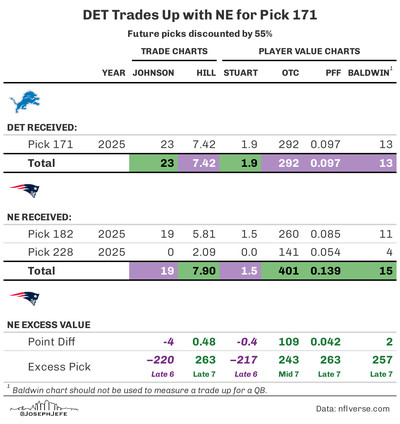
At this point in the draft, the value difference becomes of virtually no importance; the goal is to target specific players or player values, as explained by Ryan Cowden.
“Can you get to a line of players that match the value on your board?” he said. “When we say that, sometimes it does say, ‘I don’t feel great about this line of players at this pick. Can we get down to where we feel like the value matches as closely as possible to what we see or how we evaluated a player?’ A lot of the times that becomes the reason why you want to maybe move up and down.
“That’s another reason why having draft capital is important. It is currency within the draft to be able to move and either acquire players or acquire more picks to give you more swings at the plate. That movement, a lot of times is reflective of trying to match where you’ve placed value on these players on your board.”
The picks involved in this particular trade were used like this:
- Detroit: 5-171 (G Miles Frazier)
- New England: 6-182 (K Andres Borregales), 7-228 (traded to Kansas City)
Trade No. 5: Down with Kansas City
The fifth and final Patriots trade of draft weekend once again involved the Chiefs. New England send No. 228 the Kansas City for No. 251 and No. 257, the latter being the final pick in the draft.
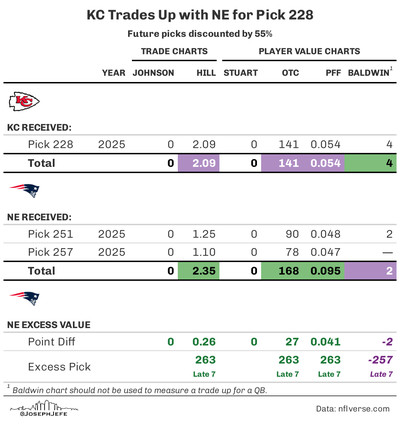
Again, the value is of little to no significance at this point in the draft. What the Patriots did with seemingly no player standing out on their board at No. 228 was turn one low-percentage dart throw into two.
The players selected at those three picks were the following:
- Kansas City: 7-228 (RB Brashard Smith)
- New England: 7-251 (LS Julian Ashby), 7-257 (CB Kobee Minor)
All in all, a few things stand out when looking at the five trades made by the Patriots on draft weekend.
The first is that maximizing the number of picks was a definitive goal of the trading process. New England succeeded in that regard, turning its original nine selections into 12 between 2025 and the 2026 fourth-rounder picked up. That approach adheres to the principles presented in a 2013 paper by Cade Massey and Richard H. Thaler titled The Loser’s Curse: Decision Making and Market Efficiency in the National Football League Draft, which — in basic terms — argues for trading down as the ultimate strategy in the draft.
In addition, the trades made in combination with Ryan Cowden’s statements afterwards suggest that the Patriots oftentimes did not have any players stand out on the board when it was their time to pick. The biggest exception came the late fourth round, when it appears defensive tackle Joshua Farmer was clearly above the rest and therefore worth targeting in a trade-up.
What we can also see is that the trades themselves were all quite even. Sure, there are some minor differences which, as noted above, can be attributed to a variety of factors. On the whole, however, there were no clearly lopsided moves when using the tools we — i.e. those outside the NFL — have available for analysis.
At the end of the day, though, the biggest factor and uncertainty in this entire process is the players the teams ended up with. When all is said and done, they will be what will be remembered about a draft.